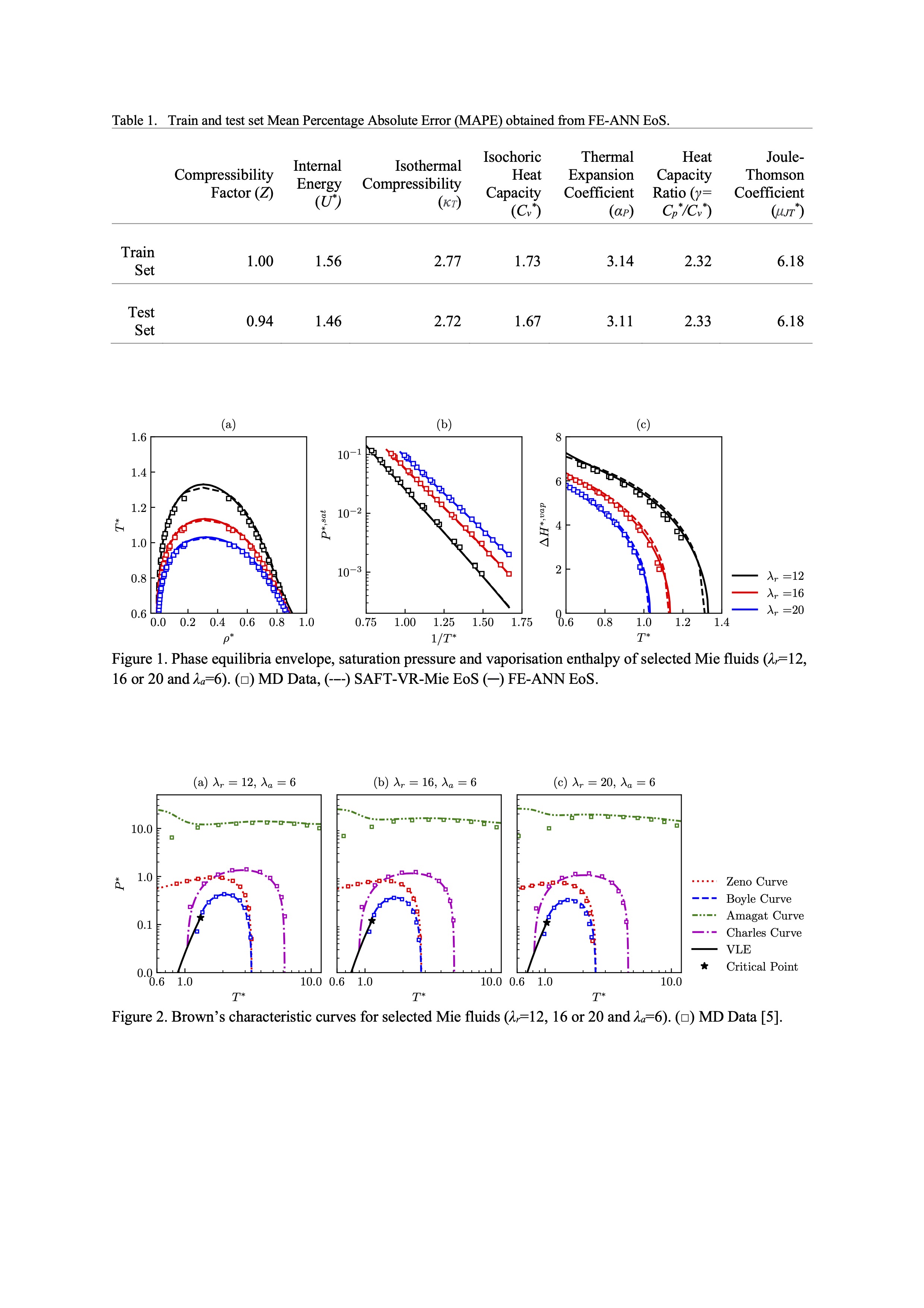(535a) Development of Thermodynamically-Consistent Machine-Learning Equations of State: Application to the Mie Fluid
AIChE Annual Meeting
2023
2023 AIChE Annual Meeting
Engineering Sciences and Fundamentals
Thermophysical Properties and Phase Behavior I
Wednesday, November 8, 2023 - 12:30pm to 12:48pm
Thermophysical properties of the Mie fluid are obtained using high-throughput Molecular Dynamics (MD) simulations. The LAMMPS software [3] is used to perform all simulations. The simulations are run with a cut-off of 5σ with no tail corrections and expressed in reduced Lennard-Jones units (i.e., equivalently to setting kb=1, ε=1 and σ=1). The MD simulations consider Mie fluids with a repulsive exponent (λr) within the range 7-34 and an attractive exponent (λa) fixed to 6. The simulated phase space considers densities (Ï*) from 10-4 to 1.2 and temperatures (T*) from 0.6 to 10.0. The computed database includes over 14000 PVT data points of the Mie fluid. These thermophysical properties are used to train the residual Helmholtz free energy model of the Mie fluid (FE-ANN EoS), defined as follows:
Ares,* = ANN(α, Ï*,1/T*) - ANN(α, Ï*=0,1/T*) ; α = C [1/( λa - 3) - 1/( λr - 3)]
Where Ares, * represents the dimensionless residual Helmholtz free energy, ANN is the neural network to be trained, and α is the van der Waals constant. The proposed formulation incorporates physical insights, e.g., it analytically fulfils the ideal gas law. Moreover, the FE-ANN EoS exactly satisfies Maxwell’s relations. This data-driven model is trained by minimising the mean squared error (MSE) with respect to first- and second-order derivative information, such as the compressibility factor (Z= P*/ Ï*T*), internal energy (U*), isothermal compressibility (κT), isochoric heat capacity (Cv*), thermal expansion coefficient (αP), heat capacity ratio (γ= Cp*/Cv*) and Joule-Thomson coefficient (μJT*). The FE-ANN EoS is implemented using TensorFlow [4].
The trained FE-ANN EoS accurately describes the Mie fluid’s target properties, as observed in Table 1. Moreover, the physical-inspired formulation of the FE-ANN EoS allows computing other properties for which the model has not been trained. For example, even though the model is trained using only PVT data, the model discovered -on its own- an unstable van der Waals loop, making it capable of computing vapour-liquid equilibria. In Figure 1, it is shown that the FE-ANN EoS model not only predicts the equilibrium densities correctly but also precisely describes the saturation pressure and vaporisation enthalpy of the selected Mie fluids.
The thermodynamic consistency of the FE-ANN EoS is also tested using Brown’s characteristic curves. These curves represent specific temperature and density conditions at which an EoS predicts the behaviour of an ideal gas for a given property. These curves include the Zeno curve (Z=1), the Boyle curve ([dZ/dP]T=0), the Charles curve ([dZ/dV]P=0) and the Amagat curve ([dZ/dT]V=0). In Figure 2, it is shown that Brown’s curves predicted by the FE-ANN EoS are physically correct. This is, the Zeno and Boyle curves converge to the same temperature at the low-pressure limit; the Zeno curve intercepts the Charles curve once; and the Boyle, Charles and Amagat curves do not cross. Moreover, the FE-ANN EoS results are in good agreement with published molecular simulation results [5], unseen by the FE-ANN EoS.
The proposed framework is capable is accurately learning the Helmholtz free energy surface of the Mie fluid. The FE-ANN EoS’s results are on par with those of SAFT-VR-Mie [6] (arguably the best model for the Mie fluid) but were obtained in a span of a few months as opposed to the decades of development needed for the SAFT-VR-Mie EoS.
References
[1] Kontogeorgis, et al. (2021). Ind. Eng. Chem. Res. 60(13), 4987–5013.
[2] Rosenberger, et al. (2022). Phys. Rev. E, 105(4), 045301.
[3] Thompson, et al. (2022). Computer Phys. Comm., 271, 108171.
[4] TensorFlow (2005). URL: https://www.tensorflow.org/ (accessed 6th October 2022)
[5] Urschel and Stephan, (2023). J. Chem. Theory Comput., 19(5), 1537–1552.
[6] Lafitte, et al. (2013). J. Chem. Phys., 139(15), 154504.
